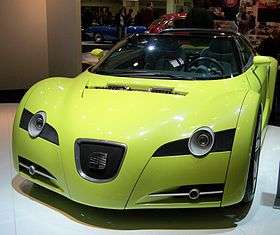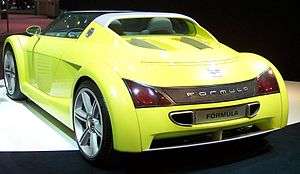SEAT Fórmula
The SEAT Fórmula is a rear-wheel-drive mid-engined roadster concept car developed by the Spanish carmaker SEAT initially aimed at limited car production.[1] Designed at the Volkswagen Group's Design Center Europe at Sitges near Barcelona a facility jointly owned by Volkswagen, Audi and SEAT,[2] it was penned by a team directed by Erwin Leo Himmel[3] into which participated the Lotus Elise designer Julian Thomson exposing the design language of the future models of the brand.
| SEAT Fórmula | |
|---|---|
 | |
| Overview | |
| Manufacturer | SEAT, SA |
| Production | 1999 (Concept car) |
| Assembly | Turin, Italy |
| Designer | Erwin Leo Himmel |
| Body and chassis | |
| Class | Sports car (S) |
| Body style | 2-door roadster |
| Layout | Mid-engine, rear-wheel-drive |
| Platform | aluminium spaceframe |
| Doors | Butterfly |
| Powertrain | |
| Engine | 2.0 L (120 cu in) 20-valve Turbocharged I4 |
| Transmission | 6-speed sequential semi-automatic |
| Dimensions | |
| Wheelbase | 2,523 mm (99.3 in) |
| Length | 3,943 mm (155.2 in) |
| Width | 1,758 mm (69.2 in) |
| Height | 1,152 mm (45.4 in) |
| Curb weight | 900 kg (2,000 lb) |

The name Fórmula itself derives from the brand's heritage from the past, as a reminding of the creation of the Spanish Fórmula Nacional race tracks back in the 1960s,[4] when SEAT started its implication in motorsport activities.[5][6]
The first concept for the car built by the Turinese company Stola was shown at the 1999 Geneva Salon international de l' auto, featuring a water-cooled 2-litre 20-valve turbo four-cylinder 240 hp engine which was riding onto an aluminium chassis weighing almost 900 kg.[7] Its 20-inch light alloy wheels (7.5 J x 20" front and 9 J x 20" rear) were fitted on 205/45 R20 front and 255/35 R20 rear tires and mounted onto an independent suspension system consisting of Formula One-style wishbones in front and horizontally mounted dampers rear system.[8] The combination of the very light chassis with the powerful engine (performing a maximum output of 240 bhp peaking at 5800 rpm and a maximum torque of 295 Nm between 2100 and 4800 rpm) and the six-speed sequential Sportronic electro-hydraulic semi-automatic gearbox,[9] both deriving from SEAT's rally cars, gave the SEAT Fórmula the ability to reach 0–100 km/h in 4.8 seconds with a top speed of 235 km/h.[10] As for the brakes, all front and rear wheels disposed ventilated disc brakes.
A 100-litre-volume luggage compartment was also available.[11]
External links
- SEAT.com corporate website
References
- SEAT Formula http://www.electrifyingtimes.com/autodesign.html
- 1999 Seat Formula http://www.conceptcarz.com/vehicle/z820/Seat-Formula.aspx
- Erwin Leo Himmel Currículum vitae http://www.motorsportscenter.com/printer_338.shtml
- http://SEAT : Formula (Geneva 1999) www.autointell.com/european_companies/volkswagen/seat/seat-formula-concept/seat21111.htm
- SEAT historia deportiva http://www.seat-mexico.com.mx/seatmx/c/MX/es/home_page/inicio_/historia/historia_deportiva.html
- SEAT: A race back in time "Archived copy". Archived from the original on 2010-02-17. Retrieved 2010-11-11.CS1 maint: archived copy as title (link)
- SEAT Formula http://www.mtm-online.de/en/highlights/details?id=13
- Out of the blue? You can Seat again! http://news.drive.com.au/drive/motor-news/out-of-the-blue-you-can-seat-again-20100823-13fqt.html
- SEAT Formula http://www.21stcentury.co.uk/cars/seat_formula.asp
- SEAT key figures http://media.seat.com/en/company/368-seat-sa-en-cifras-2005-2009.html
- SEAT Formula designstudien http://haendler.seat.de/extras/designstudien/formula/unten.htm
| Wikimedia Commons has media related to SEAT Formula. |
